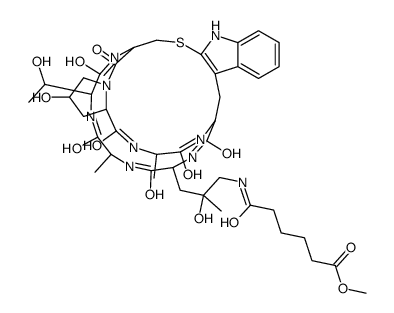17466-45-4
| Name | phalloidin |
|---|---|
| Synonyms |
EINECS 241-484-5
MFCD03427567 PHALLOIDIN Phalloidine 28-(2,3-dihydroxy-2-methylpropyl)-18-hydroxy-34-(1-hydroxyethyl)-23,31-dimethyl-12-thia-10,16,22,25,27,30,33,36-octaazapentacyclo[12.11.11.03,11.04,9.016,20]hexatriaconta-3(11),4,6,8-tetraene-15,21,24,26,29,32,35-heptone Phalloidin from Amanita phalloides Cyclic(L-alanyl-D-threonyl-L-cysteinyl-cis-4-hydroxy-L-prolyl-L-alanyl-2-mercapto-L-tryptophyl-4,5-dihydroxy-L-leucyl),cyclic (3,6)-sulfide |
| Description | Phalloidin is a mushroom-derived toxin which can be used to label F-actin of the cytoskeleton with fluorochrome(λex=495 nm, λem=520 nm). Sequence: Ala-{d-Thr}-Cys-{Hyp}-Ala-Trp-Leu (Disulfide bridge: Cys3-Cys6);A-{d-Thr}-C-{Hyp}-AWL (Disulfide bridge: Cys3-Cys6). |
|---|---|
| Related Catalog | |
| In Vitro | Phalloidin staining will not work with methanol-fixed cells, probably because of the disruption of actin filament integrity, but it will work with cells fixed in 0.2% glutaraldehyde in PBS. For fluorescein isothiocyanate (FITC)-Phalloidin (or rhodamine isothiocyanate [RITC]-Phalloidin), the excitation wavelength maximum will be near 495 nm (or 550 nm) and the emission wavelength maximum will be ~520 nm based on H2O at pH 8.0 as the solvent (575 nm with methanol as the solvent). The emission spectrum of fluorescein can depend on the environmental pH and/or ionic strength[1]. |
| Cell Assay | Prepare a 1:200 dilution of the stock solution (300 units/mL) of fluorescein Phalloidin or rhodamine Phalloidin using PBS. Aspirate the cell medium from the cells grown on glass coverslips and rinse the cells three times with PBS. Fix the cells for 10 min in the 3.7% formaldehyde solution. Rinse the fixed cells three times for 5 min each in PBS. Permeabilize the cells for 5 min in the 0.2% Triton X-100 solution. Rinse the fixed cells three times with PBS. Label the cells with the fluorescein or rhodamine Phalloidin for 5 to 10 min at room temperature. Rinse the cells three times in PBS for 5 min each time. Mount the cell and view the cells using either the fluorescein or rhodamine filter set, depending on the probe[1]. |
| References |
| Density | 1.51g/cm3 |
|---|---|
| Boiling Point | 1370.5ºC at 760mmHg |
| Molecular Formula | C35H48N8O11S |
| Molecular Weight | 788.86800 |
| Flash Point | 782.6ºC |
| Exact Mass | 788.31600 |
| PSA | 316.92000 |
| Vapour Pressure | 0mmHg at 25°C |
| Index of Refraction | 1.683 |
CHEMICAL IDENTIFICATION
HEALTH HAZARD DATAACUTE TOXICITY DATA
MUTATION DATA
|
| Symbol |

GHS06 |
|---|---|
| Signal Word | Danger |
| Hazard Statements | H300 + H310 + H330 |
| Precautionary Statements | P260-P264-P280-P284-P301 + P310-P302 + P350 |
| Hazard Codes | T+ |
| Risk Phrases | 26/27/28 |
| Safety Phrases | S22;S28;S45;S36/S37 |
| RIDADR | UN 3462 6.1/PG 2 |
| RTECS | SE9800000 |
| Hazard Class | 6.1(a) |
| Precursor 0 | |
|---|---|
| DownStream 2 | |



